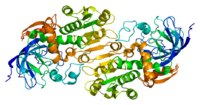
Photo from wikipedia
Aldehyde dehydrogenases (ALDHs) are a large family of enzymes that oxidize aldehydes into carboxylic acids. All ALDHs have a conserved catalytic cysteine residue, but different co-factors preference for NAD+ or… Click to show full abstract
Aldehyde dehydrogenases (ALDHs) are a large family of enzymes that oxidize aldehydes into carboxylic acids. All ALDHs have a conserved catalytic cysteine residue, but different co-factors preference for NAD+ or NADP+. We discovered a CC motif composed of the catalytic and an adjacent cysteine, which are prone to disulfide bond formation under oxidative stress. This facilitates rapid detection of and response to oxidants, as well as protects the catalytic cysteine from over-oxidation into irreversible products. In ALDHs, the CC motif only exists in NAD+-dependent ones, which leads to selective inhibition of NAD+-dependent ALDHs under oxidative stress, diverting carbon source to the NADPH producing ALDHs. This alleviates the oxidative stress and promotes cell survival. Our findings revealed a novel regulatory mechanism for ALDHs that functions in oxidative stress response. Many enzymes with catalytic cysteine residues have proximal cysteine, suggesting that such a regulatory mechanism may be general.
Journal Title: ACS chemical biology
Year Published: 2019
Link to full text (if available)
Share on Social Media: Sign Up to like & get
recommendations!